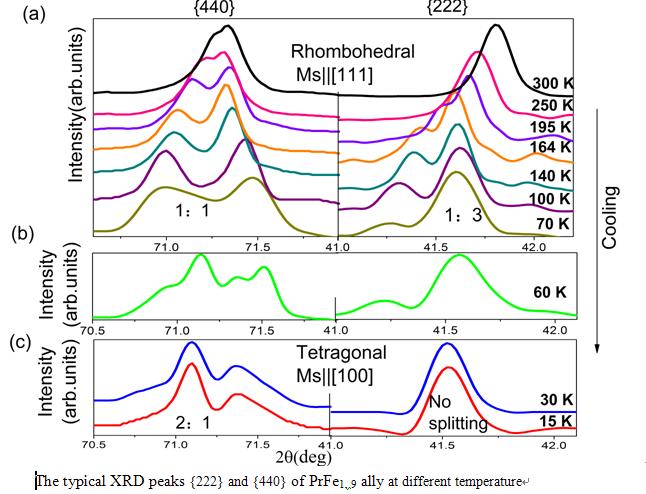Aug 15,2013|By
Recently, a new progress in PrFe2 alloy was reported by the research group of Professor Shaolong Tang in Nanjing University with the cooperation of X-ray diffraction (XRD) facility in CHMFL. It is found for the first time that the giant magnetostriction and spin reorientation in the PrFe2 with cubic Laves phase.
It was predicted theoretically that the PrFe2 ally with cubic Laves phase would exhibit giant magnetostriction as large as 5600ppm at the temperature of 0 K, which had potential application. However, it is difficult to synthesize single phase crystal with Laves phase. Therefore, the theoretically predicted giant magnetostriction has not been observed experimentally.
Professor Tang’s group synthesized the polycrystalline PrFe1.9 with single Laves phase by the high-pressure annealing method successfully. Then, they carried out investigations on the giant magnetostriction of the alloy at low temperature using the XRD facility. The results showed that different structural distortions were observed when the magnetostriction occurred to the Laves phase alloy, which corresponded to different changes of the XRD peaks. By studying the typical XRD peak {400} and {222} at different temperature, it was found that the alloy had rhombohedral symmetry from 70 K to 300 K, while it possessesed tetragonal symmetry from 15 K to 30 K. The experimental results indicated that spin reorientation occurred to PrFe1.9 alloy with the decrease of temperature. They reported the giant magnetostriction and spin reorientation in the PrFe2 for the first time using the variation-temperature XRD facility. The study results entitled “Giant low-temperature magnetostriction and spin-reorientation of polycrystalline alloy PrFe1.9 ” were published in Journal of Applied Physics.
The XRD facility of HMFL can register XRD spectrum at low temperature and high temperature. The range of low temperature rang is from 12 K to 300 K, and that of the high temperature is from 300 K to 1700 K. The range of the goniometer is from 0.1 to 140 , and the angle resolution is 0.00001 .
The paper interlinkage is: :http://jap.aip.org/resource/1/japiau/v113/i23/p233902_s1?ver=pdfcov
 |
Attachments Download: